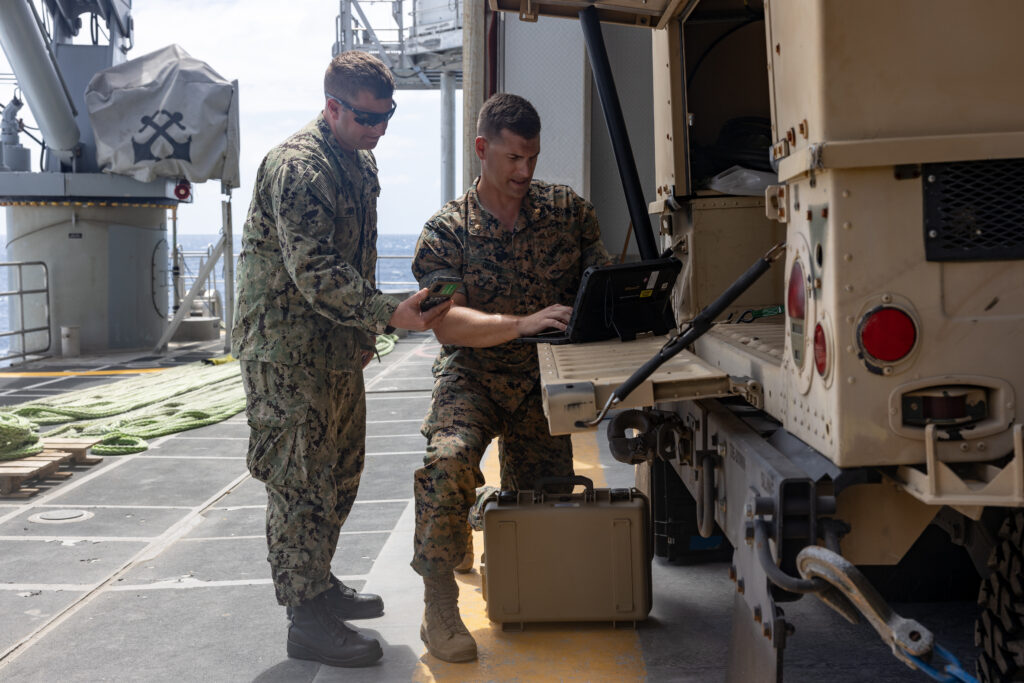
ATLANTIC OCEAN — The Spearhead-class expeditionary fast transport vessel USNS Burlington (T-EPF-10) completed U.S. Naval Forces Southern Command/U.S. 4th Fleet 2022 Fleet Experimentation events in Key West, Florida, April 22-27, 2022, said U.S. Naval Forces Southern Command / U.S. 4th Fleet said April 29.
The U.S. Southern Command area of responsibility provides a permissive environment to experiment with new technologies, tactics, techniques and procedures. U.S. Naval Forces Southern Command/U.S. 4th Fleet provides an annual experimentation venue for technology developers to embark with the operational force, evaluate new systems in the maritime environment, validate assumptions, and receive feedback from Sailors and Marines.
“The U.S. Navy must move faster, take smart risks, and focus on key operational problems to outpace our global threats,” said Dr. Christopher Heagney, NAVAIR Fleet/Force Advisor to U.S. 4th Fleet. “Our ability to establish maritime superiority in the littorals is foundational to deterring future conflict. Here, we are bringing together air, expeditionary, and information warfare to achieve that effect.”
During the week-long engagement, Burlington went to sea to perform a series of tests and demonstrations with the assistance of scientists and engineers from U.S. 4th Fleet, Office of Naval Research, Naval Information Warfare Center Atlantic, Naval Surface Warfare Centers, Naval Air Warfare Center Aircraft Division, among other science and research institutions.
Test concepts were selected based on operational needs and gaps. This year’s iteration aimed to demonstrate Navy/Marine Corps integration to protect naval assets during expeditionary advanced basing operations, by evaluating expeditionary systems for force protection and coordinated electronic warfare.
“These fleet experiments provide an important opportunity to test new ideas in a controlled environment. They also put technology experts in close contact with fleet operators to increase mutual understanding of operational problems and the state-of-the-art tools that can be leveraged to address them,” said Rear Adm. Doug Sasse, reserve vice commander of U.S. 4th Fleet. “This year’s experiments were expeditionary focused and demonstrated how spectrum dominance can provide great advantage for our forces operating in littoral waters in the U.S. 4th Fleet area of responsibility and around the globe.”
Experiments were conducted in a phased approach, with each segment building upon the previous one. A Humvee was embarked on Burlington as the primary vessel to facilitate experiments and ultimately evaluate capabilities in a contested environment.
In Phase 1, ingress, Burlington was at sea with a Humvee onboard to demonstrate electronic warfare support and establish command and control. Forces tested satellite connections, C2 through tethered aircraft, detection of simulated enemy forces, and the ship’s ability to protect itself with jamming.
Phase 2, the landing, offloaded the Humvee on Saddle Bunch Key en route to establish the EABO. The Humvee followed a route to the basing site, combating simulated attacks from unmanned aerial systems, simulated improvised explosive devices and other cyber and electronic attacks.
Finally, in Phase 3, inside force operations, the Humvee arrived at its basing site, where forces were able to establish a communications network, and conduct coordinated electronic attack tactics on simulated enemy forces.
“The ‘theater of experimentation’ is a well-earned name,” said Dr. Waleed Barnawi, ONR Program Officer. “Dr. Heagney and the 4th Fleet staff provided us a great venue to test cyber and electronic warfare capabilities, and a resilient communications architecture that will connect Navy and Marine Corps warfighters inside and outside the weapons engagement zone. I’m very grateful for Rear Adm. Sasse and his team for coming down as well. He and his team provided unique insight that only comes from an event like this.”
- DOD Releases Fiscal Year 2023 Freedom of Navigation Report - May 9, 2024
- SECDEF Announces Flag Officer Nominations - May 9, 2024
- US Coast Guard Cutter Eagle to Depart on Annual Summer Cruise - May 9, 2024



